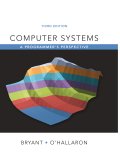
EBK COMPUTER SYSTEMS
3rd Edition
ISBN: 8220101459107
Author: O'HALLARON
Publisher: YUZU
expand_more
expand_more
format_list_bulleted
Question
Chapter 3.6, Problem 3.14PP
a.
Program Plan Intro
Test and set Instruction:
- The “TEST” instruction works same as “AND” instruction except that condition codes are been set without destination alteration.
- Either same operand is been repeated or one operands denotes mask that indicates which bits should be tested.
- The “testq” instruction performs test on quad word.
- The condition codes can be used by setting a single byte to 0 or 1 based on condition codes combination.
- The “SET” instruction has destination as either one of single byte register that has low order elements or a memory location that is single byte.
- The “setge” instruction denotes a set condition of “Greater than or equal to”.
b.
Program Plan Intro
Test and set Instruction:
- The “TEST” instruction works same as “AND” instruction except that condition codes are been set without destination alteration.
- Either same operand is been repeated or one operands denotes mask that indicates which bits should be tested.
- The “testw” instruction performs test on word.
- The condition codes can be used by setting a single byte to 0 or 1 based on condition codes combination.
- The “SET” instruction has destination as either one of single byte register that has low order elements or a memory location that is single byte.
- The “sete” instruction denotes a set condition of “equal to”.
c.
Program Plan Intro
Test and set Instruction:
- The “TEST” instruction works same as “AND” instruction except that condition codes are been set without destination alteration.
- Either same operand is been repeated or one operands denotes mask that indicates which bits should be tested.
- The “testb” instruction performs test on byte.
- The ordering relations between operands could be determined using other flags.
- The condition codes can be used by setting a single byte to 0 or 1 based on condition codes combination.
- The “SET” instruction has destination as either one of single byte register that has low order elements or a memory location that is single byte.
- The “seta” instruction denotes a set condition of “unsigned above or greater than”.
d.
Program Plan Intro
Test and set Instruction:
- The “TEST” instruction works same as “AND” instruction except that condition codes are been set without destination alteration.
- Either same operand is been repeated or one operands denotes mask that indicates which bits should be tested.
- The “testl” instruction performs test on double word.
- The ordering relations between operands could be determined using other flags.
- The condition codes can be used by setting a single byte to 0 or 1 based on condition codes combination.
- The “SET” instruction has destination as either one of single byte register that has low order elements or a memory location that is single byte.
- The “setle” instruction denotes a set condition of signed “less than or equal to”.
Expert Solution & Answer
Want to see the full answer?
Check out a sample textbook solution
Chapter 3 Solutions
EBK COMPUTER SYSTEMS
Ch. 3.4 - Prob. 3.1PPCh. 3.4 - Prob. 3.2PPCh. 3.4 - Prob. 3.3PPCh. 3.4 - Prob. 3.4PPCh. 3.4 - Prob. 3.5PPCh. 3.5 - Prob. 3.6PPCh. 3.5 - Prob. 3.7PPCh. 3.5 - Prob. 3.8PPCh. 3.5 - Prob. 3.9PPCh. 3.5 - Prob. 3.10PP
Ch. 3.5 - Prob. 3.11PPCh. 3.5 - Prob. 3.12PPCh. 3.6 - Prob. 3.13PPCh. 3.6 - Prob. 3.14PPCh. 3.6 - Prob. 3.15PPCh. 3.6 - Prob. 3.16PPCh. 3.6 - Practice Problem 3.17 (solution page 331) An...Ch. 3.6 - Practice Problem 3.18 (solution page 332) Starting...Ch. 3.6 - Prob. 3.19PPCh. 3.6 - Prob. 3.20PPCh. 3.6 - Prob. 3.21PPCh. 3.6 - Prob. 3.22PPCh. 3.6 - Prob. 3.23PPCh. 3.6 - Practice Problem 3.24 (solution page 335) For C...Ch. 3.6 - Prob. 3.25PPCh. 3.6 - Prob. 3.26PPCh. 3.6 - Practice Problem 3.27 (solution page 336) Write...Ch. 3.6 - Prob. 3.28PPCh. 3.6 - Prob. 3.29PPCh. 3.6 - Practice Problem 3.30 (solution page 338) In the C...Ch. 3.6 - Prob. 3.31PPCh. 3.7 - Prob. 3.32PPCh. 3.7 - Prob. 3.33PPCh. 3.7 - Prob. 3.34PPCh. 3.7 - Prob. 3.35PPCh. 3.8 - Prob. 3.36PPCh. 3.8 - Prob. 3.37PPCh. 3.8 - Prob. 3.38PPCh. 3.8 - Prob. 3.39PPCh. 3.8 - Prob. 3.40PPCh. 3.9 - Prob. 3.41PPCh. 3.9 - Prob. 3.42PPCh. 3.9 - Practice Problem 3.43 (solution page 344) Suppose...Ch. 3.9 - Prob. 3.44PPCh. 3.9 - Prob. 3.45PPCh. 3.10 - Prob. 3.46PPCh. 3.10 - Prob. 3.47PPCh. 3.10 - Prob. 3.48PPCh. 3.10 - Prob. 3.49PPCh. 3.11 - Practice Problem 3.50 (solution page 347) For the...Ch. 3.11 - Prob. 3.51PPCh. 3.11 - Prob. 3.52PPCh. 3.11 - Practice Problem 3.52 (solution page 348) For the...Ch. 3.11 - Practice Problem 3.54 (solution page 349) Function...Ch. 3.11 - Prob. 3.55PPCh. 3.11 - Prob. 3.56PPCh. 3.11 - Practice Problem 3.57 (solution page 350) Function...Ch. 3 - For a function with prototype long decoda2(long x,...Ch. 3 - The following code computes the 128-bit product of...Ch. 3 - Prob. 3.60HWCh. 3 - In Section 3.6.6, we examined the following code...Ch. 3 - The code that follows shows an example of...Ch. 3 - This problem will give you a chance to reverb...Ch. 3 - Consider the following source code, where R, S,...Ch. 3 - The following code transposes the elements of an M...Ch. 3 - Prob. 3.66HWCh. 3 - For this exercise, we will examine the code...Ch. 3 - Prob. 3.68HWCh. 3 - Prob. 3.69HWCh. 3 - Consider the following union declaration: This...Ch. 3 - Prob. 3.71HWCh. 3 - Prob. 3.72HWCh. 3 - Prob. 3.73HWCh. 3 - Prob. 3.74HWCh. 3 - Prob. 3.75HW